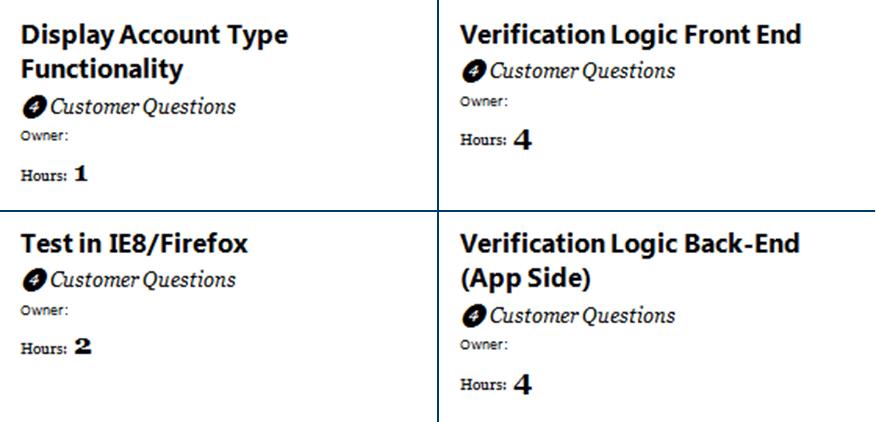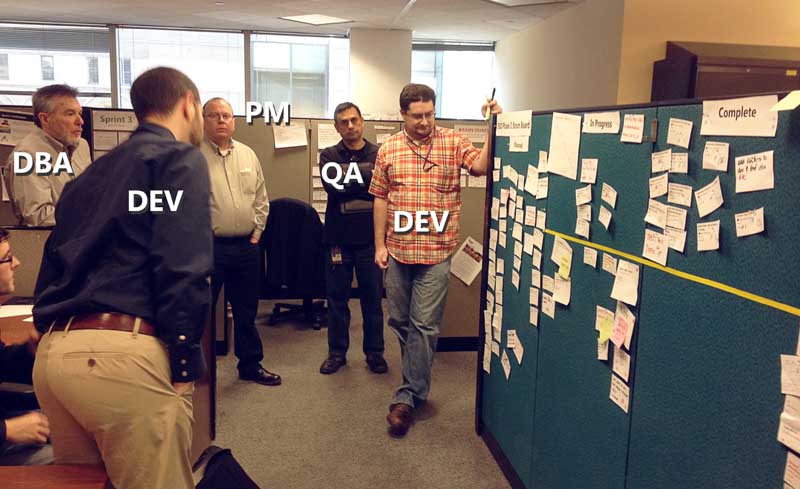
April 9, 2013 | InBrief
The scrum board: A major project management tool made of paper
The scrum board: A major project management tool made of paper
What is a scrum board? A living visualization of the work our team is doing in the current iteration. It is a series of small tasks moving from the Planned column, to In Progress, and eventually Completed. It is a great project management tool to empower teams to own tasks and communicate more frequently.
Every two weeks our team works on a series of features which we believe can be accomplished in those two weeks. We break these features down into tasks and each task is printed onto a small card. Our team's goal is to move all the cards to the "Completed" section within the two week period.
Figure 1: Tasks start off nice and printed...then are scribbled as new tasks come up.
Task Card Tips:
- We keep the task name large and bold so it is easily visible
-
Below the task title is the feature name and it's priority within the sprint
-
The owner we chose to leave blank and then hand write once claimed
- Initial hours estimate by the team
Your team actually updates this?
Every morning for 15 minutes our team meets at the board to discuss where they’re at in their work. We move tasks from Planned to In Progress, In Progress to Completed. Our team goal is that by the end of our 2-week sprint we will have accomplished all of the tasks and stories.
...the developers too?
Yes! In fact they add cards whenever new tasks are identified too. Cards do not need to be limited to just developers either, everyone is eligible to own cards and see them through to completion. By limiting the pre-assignment of cards, we encourage individuals to support the team effort and not check off just their tasks.
Figure 2: Our cross-functional team at the stand-up.
What's with the yellow line?
Cards above the yellow line are distinguished as recently updated and then tracked in a burn-down chart (also printed, displayed daily). Cards are then moved below the yellow line and grouped by feature to make the board easy to assess at a glance.
Why would I want to construct this when we are already tracking tasks in SharePoint/Excel?
Digital versions of a scrum board are not easily accessible or as present as a living board. The scrum board is a reflection (for better or worse) of the state of the project. All team members want to propel tasks across the finish line rather the pretend they do not exist.
Keep your teammates from spinning their wheels. When tasks run into dependencies, issues or blockers we place a brightly colored post-it on them with a short description. This helps quickly communicate problems to the team which can either be solved by us or need to be escalated to the appropriate person.
Since the board updated so frequently it becomes a source of truth about the project status, known as an Information Radiator. However, scrum boards are difficult for teams working remotely to collaborate on but there are options such as Trello.com and Team Foundation Server.
Stop status reporting weekly; update the scrum board daily for everyone to see! This is a burn-down chart from our current sprint. We email this to everyone on our development team and project sponsors every morning.
Figure 3: Sprint burn-down looking good below the red line

